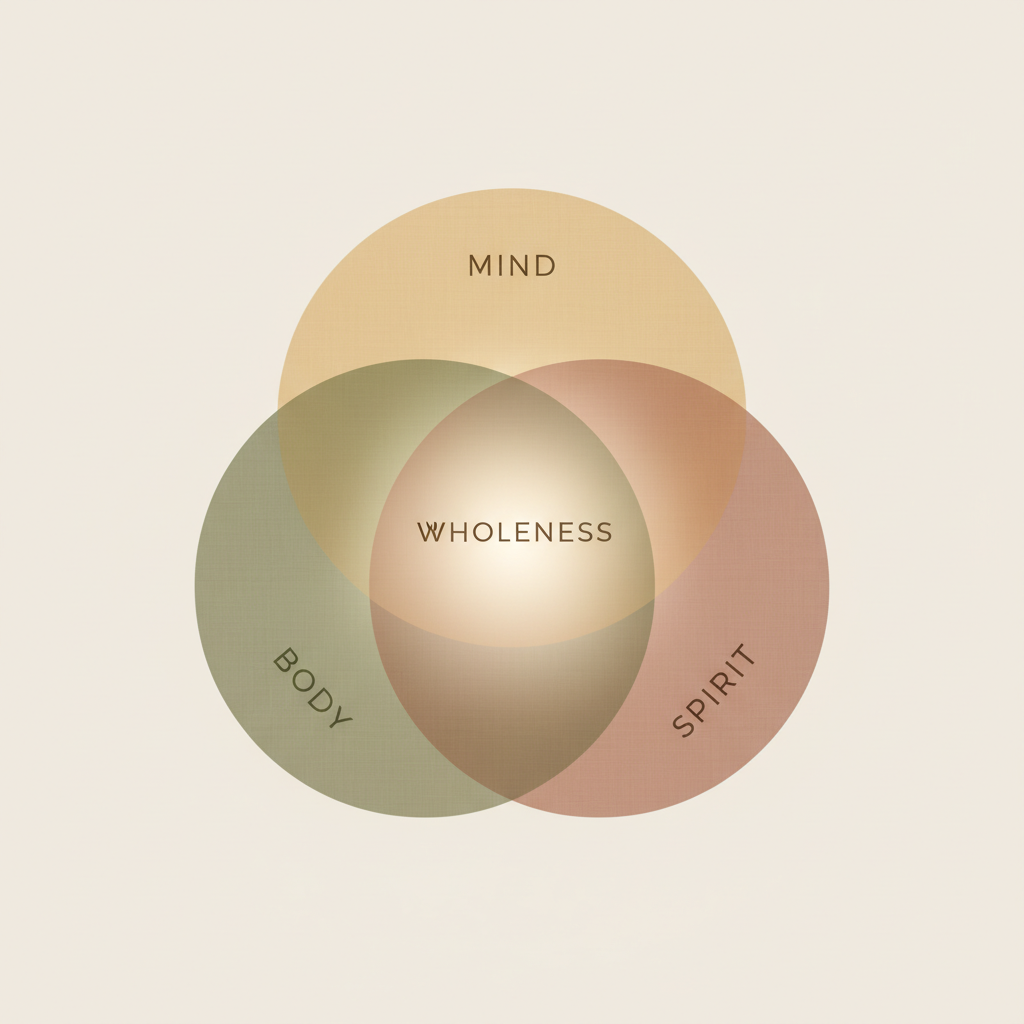If you have ever felt like you are holding your life together with duct tape while your energy quietly drains in the background, you are not alone. Burnout, people-pleasing, constant goal chasing, and second guessing your choices are symptoms of a deeper issue that rarely gets named. Fragmentation. When spiritual, mental, emotional, physical, social, and sexual energies are out of sync, the system compensates. You push harder, you distract more, and you ask others to make you feel “enough.” That is codependency. It shows up as outsourcing your peace and power to outcomes, opinions, and approval.
Before we go further: This guide is educational and not a substitute for therapy, diagnosis, or medical advice. If you’re experiencing significant distress or thoughts of self-harm, contact a licensed professional or local emergency services. Also, “codependency” is a popular term, not a formal diagnosis; we use it here to describe patterns of people-pleasing and externalized self-worth.
Here is the good news. Wholeness is possible. Not through hacks, but through principle-centered integration. Stephen Covey taught that effectiveness comes from aligning with timeless principles. David R. Hawkins taught that higher levels of consciousness come as we release force and live from truth, courage, and willingness. This is the path from codependency to True Independence. From performing for validation to building trust in yourself through consistent deposits over time.
In our work, it’s inspired by the LAB: Love, Accountability, and Trust. Love is the intention. Accountability is the structure. Trust is the result. When you integrate mind, body, and spirit across your six energy sources, you stop leaking power and start compounding it. You stop trying to win other people’s scoreboards and start playing your game, your way, with integrity.
A quick frame for wholeness
We measure performance capacity as 20 percent Fitness, 30 percent Lifestyle, and 50 percent Consciousness. Fitness is your physical margin. Lifestyle is how you design your environment, routines, and relationships. Consciousness is the quality of your awareness and intention. Most people overtrain the physical, undertrain the spiritual and emotional, and ignore the social and sexual altogether. Integration is the practice of bringing all six online so they support each other.
The shift begins with three truths:
– Principles before preferences. Principle-centered choices create durable results.
– Deposits beat intensity. Small, consistent actions bank trust in yourself.
– Scoreboards create clarity. What you measure improves.
Research snapshot (why these truths work)
– Habit formation: Small, consistent actions become automatic over time (Lally et al., 2009, European Journal of Social Psychology).
– Implementation intentions: If–Then plans dramatically improve follow-through (Gollwitzer & Sheeran, 2006, Advances in Experimental Social Psychology).
– Self-monitoring: Tracking behavior increases goal attainment (Harkin et al., 2016, Psychological Bulletin).
– Mindfulness: Brief practices reduce rumination and improve emotion regulation (Khoury et al., 2015; Goldberg et al., 2018).
– Sleep, movement, nutrition: Foundational habits bolster cognitive control and mood (Goldstein & Walker, 2014; Schuch et al., 2016; Willett et al., 2019).
– Social connection: High-quality relationships significantly improve health and resilience (Holt-Lunstad et al., 2010, PLoS Medicine).
The tools that make wholeness practical
– Trust App. Your daily deposit across seven building blocks, and your weekly scoreboard that shows if your habits are compounding.
– A.I.M. Methodology: Activate, Integrate, Measure. A simple loop that turns ideas into embodied habits.
– Possibility Triangle: Faith, Trust, Surrender. A lens for transmuting people-pleasing and self doubt into aligned action.
– Possibility Continuum. A way to stop burnout from goal chasing by focusing on state, then strategy, then scale.
– GameDay Fitness Assessment. A baseline check of your physical and metaphysical connection so you understand your margin and where leaks occur.
A simple tutorial to integrate the six energies
Step 1: Take inventory
Rate each energy source from one to ten. Ten is abundant and aligned, one is depleted.
– Spiritual. Do you have a daily moment of stillness, prayer, or meditation that centers you before you enter the day’s game?
– Mental. Can you focus for ninety minutes without distraction? Are you reading, learning, and thinking clearly?
– Emotional. Do you recognize and regulate your emotions, or are you reacting and suppressing?
– Physical. Are you sleeping deeply, moving daily, and fueling in a way that sustains energy, not just spikes it?
– Social. Are your relationships reciprocal, or are you rescuing, fixing, and appeasing?
– Sexual. Do you honor your sexual energy with presence and integrity, or is it scattered, numbed, or negotiated for validation?
Do not moralize the numbers. This is not about good or bad. This is data. That which is measured, can be improved.
Step 2: Establish your baseline with the GameDay
Take a GameDay. We are looking for two things: your physical margin and your metaphysical connection. Margin answers, how much can you perform without dipping into stress debt. Connection answers, can you feel your body and breath while you perform. Many achievers can grind but cannot feel. That is a trust leak. The GameDay snapshot will show where your physical training, breath, and focus align, and where they split. This is your starting line.
Step 3: Design small deposits in each energy
Forget overhauls. We build trust through deposits. Choose one simple deposit for each energy that you can perform even on your worst day. Here are effective examples.
– Spiritual. Two minutes of breath prayer or meditation before touching your phone in the morning. Deposit scored as yes or no.
– Mental. One ninety minute deep work block, phone outside the room. Deposit scored as minutes focused.
– Emotional. Three lines of journaling naming what you feel, what you need, and what you choose. Deposit scored as yes or no. Evidence: Brief journaling improves clarity and emotion regulation (Smyth, 1998; Burton & King, 2008).
– Physical. Ten thousand steps or thirty minutes of movement. Deposit scored as steps or minutes. Evidence: Exercise improves mood and stress resilience (Schuch et al., 2016).
– Social. One intentional check in with a high trust relationship where you share a win, a challenge, and a request. Deposit scored as yes or no. Evidence: Supportive ties predict better health and lower stress (Holt-Lunstad et al., 2010).
– Sexual. Ten minutes of embodied practice that honors your stage of life. This may be mindful intimacy with your partner, or solo breathwork that circulates energy without compulsion. Deposit scored as yes or no. Evidence: Mindfulness-based approaches can enhance sexual well-being and reduce distress (Brotto & Basson, 2014).
Daniel Reid’s perspective on energy circulation, Blue Zones research on lifestyle design, and Tony Robbins’ emphasis on state all point to the same principle: when you make small daily deposits, your state stabilizes and your choices improve. Pair these with peer-reviewed findings above for a grounded approach.
Step 4: Run A.I.M. cycles
A.I.M. turns intention into traction.
– Activate. Choose one deposit for yourself and create consistency with it.
– Integrate. Stack deposits onto existing routines. Breath before phone. Deep work after coffee. Walk while taking one call. Journal before dinner. Intimacy after a shared gratitude. Make it friction light.
– Measure. Use the Scoreboard each week. Green means you did the deposit. Yellow means partial. Red means miss. No drama. Just data. Adjust the next two week sprint based on patterns. Research shows measurement itself boosts success (Harkin et al., 2016).
Step 5: When resistance shows up, use the Possibility Triangle
People-pleasing and self doubt are not signs to quit. They are signals to reinforce Faith, Trust, and Surrender.
– Faith. You are building True Independence by making deposits, not chasing approval.
– Trust. You can rely on yourself because you are tracking the work, not guessing.
– Surrender. Release the outcome fixation. You do the deposit today. You let compounding do its job.
Hawkins would call this moving from Force to Power. You are no longer forcing outcomes. You are aligning with truth and allowing results to emerge.
Step 6: Use the Possibility Continuum to prevent burnout
Instead of jumping to big goals, move along the continuum.
– State. Regulate your energy first. Breath, sleep, sunlight, water. This is your 20 percent Fitness and your 50 percent Consciousness. Evidence: Sleep quality shapes emotion and cognition (Goldstein & Walker, 2014).
– Strategy. Choose the smallest high leverage deposits. Evidence: If–Then planning improves execution (Gollwitzer & Sheeran, 2006).
– Scale. Only when your weekly Scoreboard is green two weeks in a row do you add complexity or intensity.
This continuum keeps you from inflating ambition faster than your capacity. It protects trust.
Step 7: Upgrade deposits as you stabilize
After two clean sprints, upgrade one deposit at a time.
– Spiritual. Two minutes becomes five. Then occasional silent sits on weekends.
– Mental. One deep work block becomes two, with clear shutdown rituals.
– Emotional. Add a weekly emotional inventory. Name resentments and take responsibility for your requests. Evidence: Self-compassion practices support resilience and reduced shame (Neff & Germer, 2013).
– Physical. Layer strength twice per week. Refine nutrition with a simple plate strategy. Evidence: Whole-food dietary patterns improve health outcomes (Willett et al., 2019).
– Social. Curate your Trust Tribe. Increase time with reciprocal relationships. Create boundaries with energy takers. Evidence: Social support buffers stress responses (Ozbay et al., 2007).
– Sexual. Deepen presence and communication with your partner. Agree on rituals that honor consent, timing, and care. For solo practitioners, keep your practice honest and aligned with your values. Evidence: Mindfulness-based sex therapy shows promising outcomes (Brotto & Basson, 2014).
Application in real life: a client example
Meet Jordan. High performer, kind heart, always “there” for everyone, yet exhausted. Mornings started on email, workouts were sporadic, and intimacy felt like a scoreboard for worth. Jordan rated the six energies like this: Spiritual 3, Mental 6, Emotional 4, Physical 7, Social 5, Sexual 4.
Then we look at the GameDay feedback. Physically capable, metabolically okay, but breath collapsed under stress and focus fractured at the ninety minute mark. That told us the leaks were more Consciousness than Fitness.
We activated a fourteen day A.I.M. sprint with minimal deposits:
– Two minutes of breath before phone.
– One ninety minute deep work block, phone outside the door.
– Three line emotion journal before dinner.
– Ten thousand steps daily.
– One intentional check in with a trusted friend each week.
– Ten minutes of mindful intimacy practice twice per week.
We integrated the deposits into existing routines and measured them. The first week was mostly green with two yellow marks. Resistance showed up as guilt for not answering texts instantly and fear that a smaller workload block would hurt performance. We used the Possibility Triangle. Faith in the principle that deposits compound. Trust in the Scoreboard. Surrender the need to fix everyone’s day.
By week four, Jordan’s Balance Chart shifted to Spiritual 6, Mental 7, Emotional 6, Physical 8, Social 7, Sexual 6. Not perfect. Whole. The visible wins were steady energy, clearer boundaries, and intimacy that felt connected rather than transactional. The invisible win was trust. Jordan was playing the long game with consistent deposits. That is True Independence.
Why this works
– Principle-centered. As Covey taught, principles are external realities we align with, not internal preferences we negotiate. You do the right thing because it works, not because you feel like it.
– Measurable. The Balance Chart and Scoreboard turn vague intentions into trackable behaviors. No more “trying.” You have data. Backed by self-monitoring research (Harkin et al., 2016).
– Holistic. The six energies are interdependent. A small spiritual deposit stabilizes your emotional world. A simple social boundary improves sleep. Mindful sexual energy circulates vitality rather than scattering it. The system stops fighting itself. Supported by evidence on mindfulness, social support, sleep, and exercise.
– Community. Your Trust Tribe amplifies deposits. You do not rescue each other. You reinforce accountability and love.
Practical tips to stay consistent
– Start so small that missing feels absurd. Two minutes beats zero.
– Put deposits on the calendar as non negotiable appointments with yourself.
– Use a visible scoreboard. Seeing green patterns is motivating.
– Anchor deposits to triggers you already do. Breath when your feet touch the floor. Journal when you close your laptop. Walk while you take the afternoon call.
– Review weekly. Ask, what gave me energy, what drained it, what will I adjust.
– Celebrate integrity, not outcomes. When you keep your word to yourself, you win.
Frequently asked questions
What if I miss a day? You do not start over. You re enter. Deposit today, measure on Sunday, adjust next week. Trust grows when you return without drama.
What if I feel selfish creating boundaries? That is codependency talking. Accountability to your principles is an act of love for others because it brings your best self to them. You cannot give what you do not have.
How do I know when to scale deposits? When your two week say/do ratio is eighty percent green or more, and your body feels stable rather than strained.
Integrating sexual energy with integrity
This domain is often ignored or outsourced to validation. Wholeness requires you to honor this energy. That means presence, consent, communication, and care. Mindful intimacy is not about performance. It is about connection. For singles and those practicing solo, it is about cultivating energy without compulsion, using breath, movement, and honest self reflection. As Hawkins would frame it, lift the energy from shame and guilt into courage and acceptance. Research on mindfulness in sexual health suggests benefits for desire, arousal, and well-being (Brotto & Basson, 2014). As Daniel Reid notes, circulate rather than scatter. This is not moralizing. It is effective energy management.
Your transformation: from codependency to True Independence
When you live by principle and use the tools of the YDBG to support you in this, you stop begging for certainty from others and start building certainty within. You shift from people pleasing to self leadership. You stop chasing the next finish line and start compounding deposits. Your life becomes a series of GameDays where you trust your training. You measure, you adjust, and you grow.
Love, Accountability and Balance are the LAB where you practice your wholeness. Every deposit says, I can rely on myself. Every boundary says, I respect this life. Every scoreboard review says, I am responsible for my path. That is True Independence.
Your next step
– Join the Trust App waitlist to access the Balance Chart and Scoreboard. Put your deposits on the field and watch your trust compound.
– Book a GameDay Fitness Assessment to establish your physical and metaphysical baseline. Know your margin and your leaks.
– If you want coaching support and a Trust Tribe to hold you accountable with love, book a clarity call. We will map your next A.I.M. sprint together.
Wholeness is not a mystery. It is a set of small, principle-centered deposits made consistently across your six energies. Start today. Breathe before phone. Walk while you think. Name your feelings. Call someone who wants the best for you. Practice presence with your partner, or with yourself. Then record the deposit. That is how you integrate mind, body, and spirit. That is how you build a life you can trust.
Selected research and further reading
– Lally, P. et al. (2009). European Journal of Social Psychology – How habits form in everyday life.
– Gollwitzer, P. & Sheeran, P. (2006). Advances in Experimental Social Psychology – Implementation intentions and goal achievement.
– Harkin, B. et al. (2016). Psychological Bulletin – Monitoring goal progress promotes goal attainment.
– Khoury, B. et al. (2015). Clinical Psychology Review – Mindfulness-based therapy: a comprehensive meta-analysis.
– Goldberg, S. et al. (2018). Clinical Psychology Review – Mindfulness-based interventions for psychiatric disorders: a review and meta-analysis.
– Goldstein, A. & Walker, M. (2014). Annual Review of Clinical Psychology – The role of sleep in emotional brain function.
– Schuch, F. et al. (2016). Journal of Psychiatric Research – Exercise as a treatment for depression: meta-analysis.
– Willett, W. et al. (2019). Science – Diet and health: What should we eat?
– Holt-Lunstad, J. et al. (2010). PLoS Medicine – Social relationships and mortality risk.
– Ozbay, F. et al. (2007). Psychiatry (Edgmont) – Social support and resilience to stress.
– Brotto, L. & Basson, R. (2014). Sexual and Relationship Therapy – Group mindfulness-based therapy for sexual well-being.







